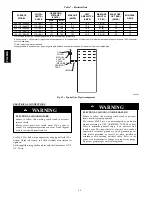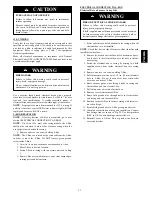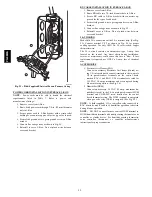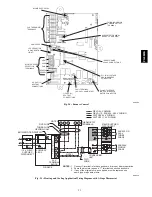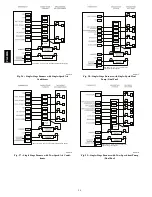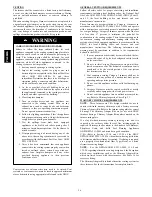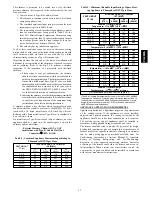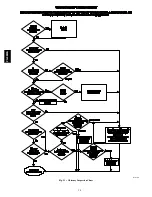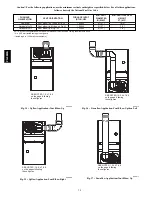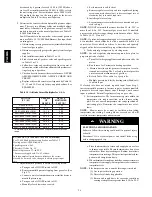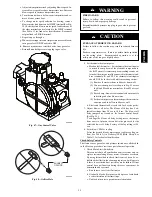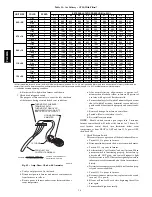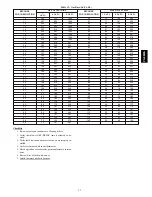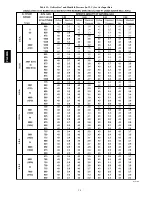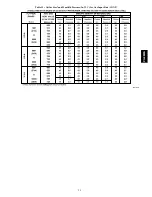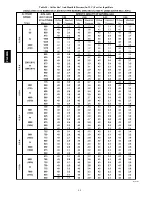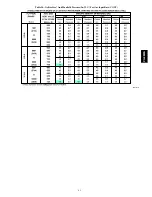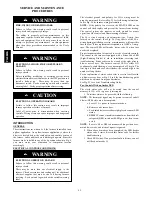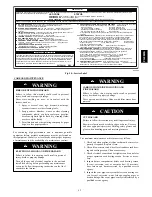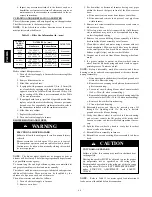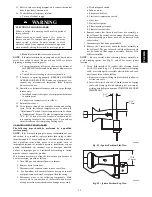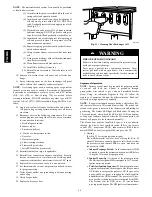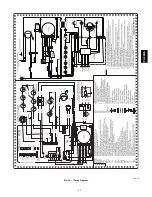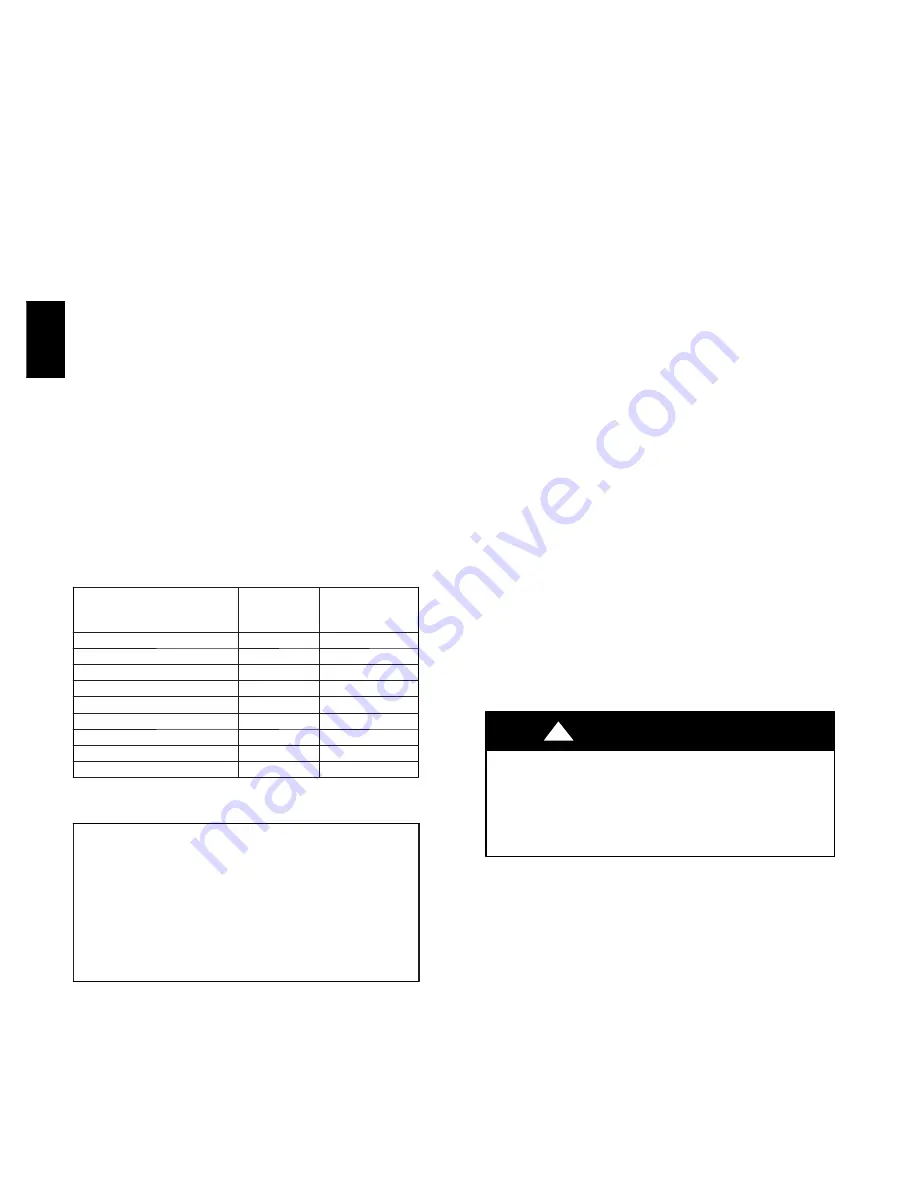
34
be reduced by 4 percent for each 1,000 ft. (305 M) above
sea level. For installations below 2000 ft. (610 M), refer to
the unit rating plate. For installations above 2000 ft. (610
M), multiply the input on the rating plate by the de--rate
multiplier in Table 8 for the correct input rate.
2. Determine the correct orifice and manifold pressure adjust-
ment. There are two different orifice and manifold adjust-
ment tables. All models in all positions, except Low NOx
models in downflow or horizontal positions, use Table 13
(22,000 Btuh/Burner).
Low NOx models in the downflow or horizontal positions
must use Table 14 (21,000 Btuh/Burner). See input listed
on rating plate.
a. Obtain average yearly gas heat value (at installed altitude)
from local gas supplier.
b. Obtain average yearly gas specific gravity from local gas
supplier.
c. Find installation altitude in Table 13 or 14.
d. Find closest natural gas heat value and specific gravity
in Table 13 or 14.
e. Follow heat value and specific gravity lines to point of
intersection to find orifice size and manifold pressure set-
tings for proper operation.
f. Check and verify burner orifice size in furnace. NEVER
ASSUME ORIFICE SIZE. ALWAYS CHECK AND
VERIFY.
g. Replace orifice with correct size if required by Table 10,
12, 13 and 14. Use only factory--supplied orifices. See
EXAMPLE 1.
Table 10 – Altitude Derate Multiplier for U.S.A.
ALTITUDE
(FT. / M)
PERCENT
OF
DERATE
DERATE
MULTIPLIER
FACTOR*
0–2000 (0---610)
0
1.00
2001–3000 (610---914)
8–12
0.90
3001–4000 (914---1219)
12–16
0.86
4001–5000 (1219---1524)
16–20
0.82
5001–6000 (1524---1829)
20–24
0.78
6001–7000 (1829---2134)
24–28
0.74
7001–8000 (2134---2438)
28–32
0.70
8001–9000 (2438---2743)
32–36
0.66
9001–10,000 (2743---3048)
36–40
0.62
* Derate multiplier factors are based on midpoint altitude for altitude
range.
EXAMPLE 1: (0 to 2000 ft. (0 to 610 M) altitude)
For 22,000 Btuh per burner application use Table
13
.
Heating value = 1000 Btuh/cu ft.
Specific gravity = 0.62
Therefore: Orifice No. 43*
Manifold pressure: 3.7--In. W.C.
*Furnace is shipped with No. 43 orifices.
In this example all main burner orifices are the correct
size and do not need to be changed to obtain proper input
rate.
3. Adjust manifold pressure to obtain correct input rate.
a. Turn gas valve ON/OFF switch to OFF.
b. Remove manifold pressure tap plug from gas valve. (See
Fig. 47.)
c. Connect a water column manometer or similar device to
manifold pressure tap.
d. Turn gas valve ON/OFF switch to ON.
e. Manually close blower door switch.
f. Set thermostat to call for heat.
g. Remove regulator seal cap and turn regulator adjusting
screw counterclockwise (out) to decrease input rate of
clockwise (in) to increase input rate.
h. Install regulator seal cap.
i. Leave manometer or similar device connected and pro-
ceed to Step 4.
NOTE
: DO NOT set manifold pressure less than 3.2--In. W.C. or
more than 3.8--In. W.C. for natural gas at sea level. If manifold
pressure is outside this range, change main burner orifices. Refer
to Table 10, 12, 13 and 14.
NOTE
: If orifice hole appears damaged or it is suspected to have
been redrilled, check orifice hole with a numbered drill bit of
correct size. Never redrill an orifice. A burr--free and squarely
aligned orifice hole is essential for proper flame characteristics.
4. Verify natural gas input rate by clocking meter.
NOTE
: Gas valve regulator adjustment cap must be in place for
proper input to be clocked.
a. Turn off all other gas appliances and pilots served by the
meter.
b. Run furnace for 3 minutes in heating operation.
c. Measure time (in sec) for gas meter to complete 1 revolu-
tion and note reading. The 2 or 5 cubic feet dial provides
a more accurate measurement of gas flow.
d. Refer to Table 12 for cubic ft. of gas per hr.
e. Multiply gas rate (cu ft./hr) by heating value (Btuh/cu ft.)
to obtain input.
If clocked rate does not match required input from Step 1,
increase manifold pressure to increase input or decrease manifold
pressure to decrease input. Repeat steps b through e until correct
input is achieved. Reinstall regulator seal cap on gas valve.
5. Set temperature rise. The furnace must operate within the
temperature rise ranges specified on the furnace rating
plate. Do not exceed temperature rise range specified on
unit rating plate. Determine the temperature rise as fol-
lows:
NOTE
: Blower access door must be installed when taking
temperature rise reading. Leaving blower access door off will
result in incorrect temperature measurements.
ELECTRICAL SHOCK HAZARD
Failure to follow this warning could result in personal injury
or death.
Disconnect 115--v electrical power and install lockout tag
before changing speed tap.
!
WARNING
a. Place thermometers in return and supply ducts as close
to furnace as possible. Be sure thermometers do not see
radiant heat from heat exchangers. Radiant heat affects
temperature rise readings. This practice is particularly im-
portant with straight--run ducts.
b. When thermometer readings stabilize, subtract return--air
temperature from supply--air temperature to determine air
temperature rise.
NOTE
: If the temperature rise is outside this range, first check:
(1.) Gas input for heating operation.
(2.) Derate for altitude if applicable.
(3.) Return and supply ducts for excessive restrictions
causing static pressures greater than 0.50--In. W.C.
PG
8M
EA
Summary of Contents for PG8JEA
Page 4: ...4 A10269 Fig 2 Clearances to Combustibles PG8MEA ...
Page 28: ...28 A10133 Fig 33 Chimney Inspection Chart PG8MEA ...
Page 38: ...38 Table 13 Orifice Size and Manifold Pressure In W C for Gas Input Rate A10180 PG8MEA ...
Page 39: ...39 Table 13 Orifice Size and Manifold Pressure In W C for Gas Input Rate CONT A10180A PG8MEA ...
Page 40: ...40 Table 14 Orifice Size And Manifold Pressure In W C For Gas Input Rate A10181 PG8MEA ...
Page 41: ...41 Table 14 Orifice Size And Manifold Pressure In W C For Gas Input Rate CONT A10181A PG8MEA ...

